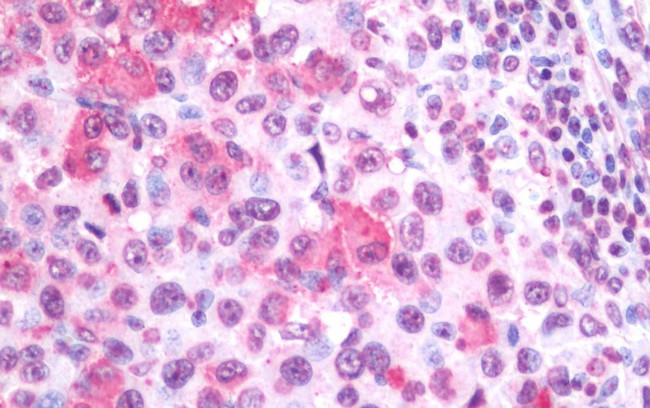Search Thermo Fisher Scientific
Product Details
PA5-33112
Species Reactivity
Host/Isotype
Class
Type
Immunogen
Conjugate
Form
Concentration
Purification
Storage buffer
Contains
Storage conditions
Shipping conditions
RRID
Product Specific Information
Percent identity with other species by BLAST analysis: Human, Gorilla, Gibbon, Monkey, Marmoset, Dog, Bovine, Bat, Elephant, Panda, Rabbit (100%); Rat, Hamster, Opossum (94%).
For IHC(P), use heat induced antigen retrieval in pH 6.0 citrate buffer. After incubation with the primary antibody, slides were incubated with biotinylated secondary antibody, followed by alkaline phosphatase-streptavidin and chromogen.
Target Information
The WNT gene family consists of structurally related genes which encode secreted signaling proteins. These proteins have been implicated in oncogenesis and in several developmental processes, including regulation of cell fate and patterning during embryogenesis. This gene is a member of the WNT gene family. It is strongly expressed in the cell lines of promyelocytic leukemia and Burkitt's lymphoma. In addition, it and another family member, the WNT6 gene, are strongly coexpressed in colorectal cancer cell lines. The gene overexpression may play key roles in carcinogenesis through activation of the WNT-beta-catenin-TCF signaling pathway. This gene and the WNT6 gene are clustered in the chromosome 2q35 region.
For Research Use Only. Not for use in diagnostic procedures. Not for resale without express authorization.
References (0)
Bioinformatics
Protein Aliases: Protein Wnt-10a; wingless-type MMTV integration site family member 10A; wingless-type MMTV integration site family, member 10A
Gene Aliases: OODD; SSPS; STHAG4; WNT10A
UniProt ID: (Human) Q9GZT5
Entrez Gene ID: (Dog) 488528, (Rabbit) 100352839, (Bovine) 537330, (Human) 80326

Performance Guarantee
If an Invitrogen™ antibody doesn't perform as described on our website or datasheet,we'll replace the product at no cost to you, or provide you with a credit for a future purchase.*
Learn more
We're here to help
Get expert recommendations for common problems or connect directly with an on staff expert for technical assistance related to applications, equipment and general product use.
Contact tech support




